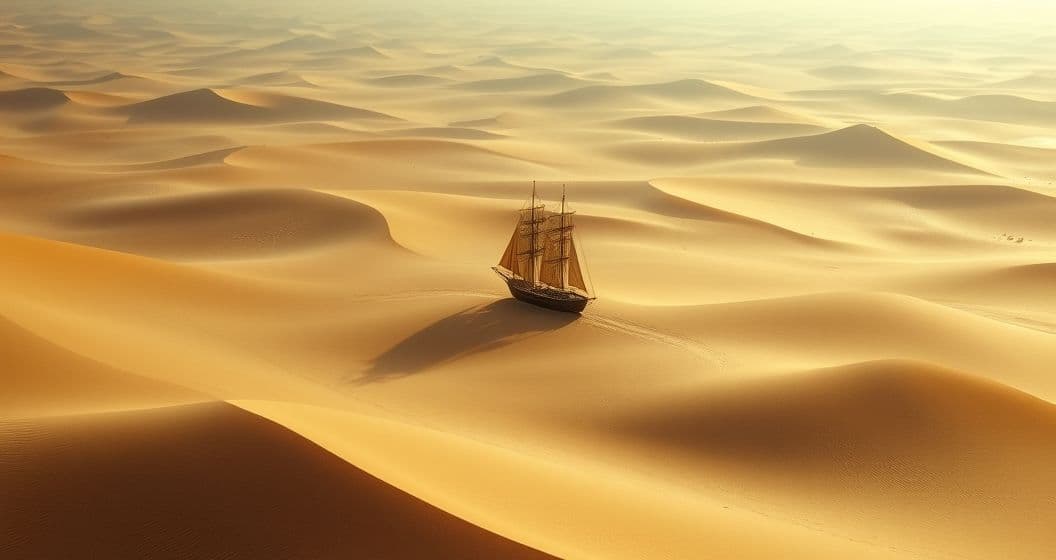Core Symbols: The Ship and the Desert
The paradox at the heart of a ship-in-desert dream lies in its most fundamental elements: a vessel designed for water navigating a terrain defined by its absence. The ship itself is rarely neutral—it often embodies your sense of self as a journeying entity, carrying hopes, fears, or unfinished business. A sleek sailboat might signal grace under pressure, while a battered cargo ship could reflect burdened purpose. The desert, conversely, is a landscape of transformation, where scarcity forces reevaluation. In mythologies from the Arabian Nights to ancient Mesopotamia, deserts represent thresholds—places where old identities dissolve, and new purpose emerges. Imagine a dreamer who sails a small rowboat through shifting sand dunes, the hull occasionally sinking into soft drifts; this isn’t just a strange image—it’s a metaphor for how you’re adapting to life’s unexpected 'tides' of change.
Psychology Lens: Jungian Landscapes and Cognitive Maps
From a Jungian perspective, the desert ship embodies the 'Self'—the psyche’s attempt to navigate the unconscious's arid regions. The ship, a vessel of the conscious mind, sails through the desert’s vastness to confront the shadow: those parts of yourself you’ve neglected or feared. In neuroscience terms, REM sleep (when most vivid dreams occur) activates the default mode network, where the brain processes emotions and memories. A desert ship dream might be your brain’s way of integrating stressors, using the absurdity of a ship in a desert to highlight the disconnect between your goals and current circumstances. Consider Carl Jung’s 'active imagination': the desert isn’t just a setting—it’s a mirror of your inner landscape, urging you to ask, 'What am I avoiding by clinging to old paths?'
Want a More Personalized Interpretation?
Get your own AI-powered dream analysis tailored specifically to your dream
🔮Try Dream Analysis FreeLife Triggers: When the Desert Calls
These dreams often arise during periods of transition, whether literal (moving to a new city, ending a relationship) or metaphorical (career pivots, identity shifts). If you’ve recently felt 'adrift'—unmoored from routine or purpose—the desert becomes a stand-in for that uncertainty. A job loss, for example, might turn your life into a metaphorical desert, and the ship your mind’s attempt to 'sail forward' despite dry land. Digital age triggers matter too: endless scrolling through social media can create a 'digital desert' of connection, where the ship represents your longing for authentic interaction. Even a recent hike in a dry region or a documentary about desert exploration can plant seeds, as your brain processes new sensory data into symbolic dreams.
What To Do Next: From Dream to Action
Start with short-term reflection: Grab a notebook and ask, 'What was the ship carrying? Was the desert still or stormy? How did I feel as captain?' This anchors the dream in your unique experience. Medium-term, experiment with 'watering your ship': if the desert feels empty, seek small rituals that nourish purpose—whether learning a new skill, reconnecting with a forgotten hobby, or volunteering. Long-term, create a 'navigational map' of values: list three non-negotiable principles that guide your life. When the desert feels endless, these become your compass. Remember, the ship isn’t lost—it’s exploring a new sea.
FAQ
Q: What if the ship is sinking in the desert?
A: A sinking ship in a desert dream reflects anxiety about losing control, even in dry circumstances. It may signal fear of failing to adapt to change, urging you to let go of rigid plans and trust flexibility.
Q: Does the desert’s condition (stormy vs. calm) matter?
A: Stormy deserts mirror emotional turbulence; calm ones suggest resilience despite uncertainty. The weather reflects how you’re processing life’s 'storms' or finding peace in stillness.
Q: Why dream of a ship in a desert if I don’t like water?
A: The ship isn’t about water—it’s about purpose and direction. Your aversion to water might highlight resistance to emotional depth, while the desert pushes you to navigate without relying on old methods.
